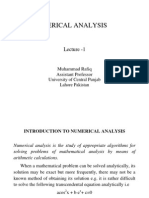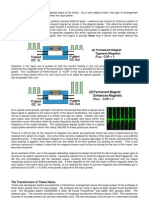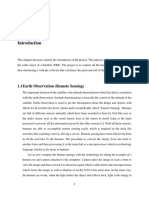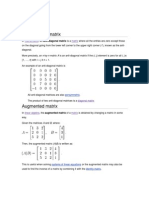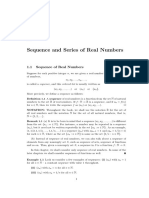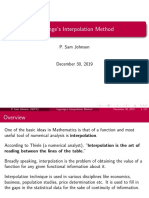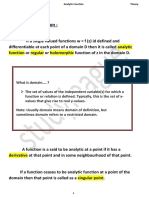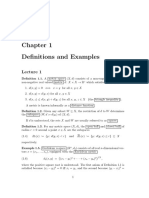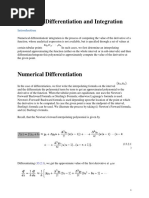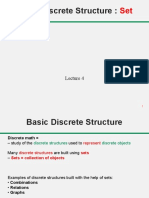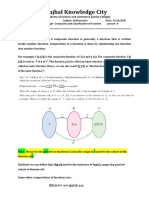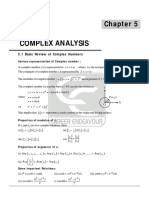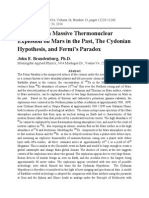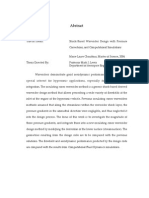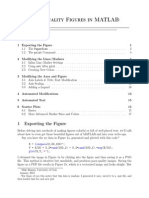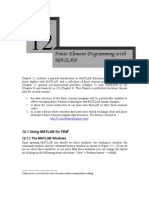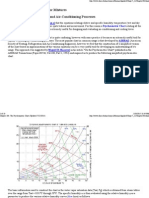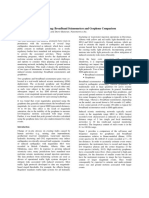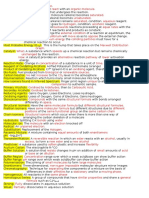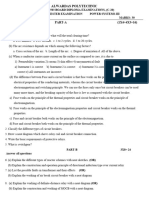Pursuit Curves
Pursuit Curves
Uploaded by
megustalazorraCopyright:
Available Formats
Pursuit Curves
Pursuit Curves
Uploaded by
megustalazorraCopyright
Available Formats
Share this document
Did you find this document useful?
Is this content inappropriate?
Copyright:
Available Formats
Pursuit Curves
Pursuit Curves
Uploaded by
megustalazorraCopyright:
Available Formats
Pursuit Curves
Katy Steiner, Jonah Franchi
5/10/2011
Abstract
The purpose of this paper is to demonstrate and explain how pursuit
curves are derived and modeled, give examples of dierent types of pursuit
curves, and nally show a more complex pursuit curve in 3-D space.
1
1 Introduction & Assumptions
A pursuit curve is, as its name implies, a curve showing the path an object takes
as it pursues another object. The velocity vector of the pursuer is always going
directly towards the prey, which excluding the idea of bending space time, is
a straight line. In order to model pursuit curves a few assumptions must be
made. First, all prey are following a set path at a constant speed. Second, there
is nothing in the way of either prey or predator and they have unlimited energy.
2
2 A Basic Pursuit Curve
(All of the proceeding in the section was found and derived by
http://online.redwoods.cc.ca.us/instruct/darnold/deproj/sp08/mseverdia/pursuit.pdf)
For our rst example of a pursuit curve, consider our predator being a missile
and our prey, a ship.
The ship starts at (x
0
, 0) at t 0 and is traveling at V
s
along the vertical
line x = x
0
. The missile starts at (0, 0) at time t = 0 and travels at a constant
speed of V
m
along a curved path so that its velocity vector is pointing directly
at the ship.
If the missile at time t 0 is the point (x, y) and the position of the ship is
(x
0
, V
s
t) then the slope of the tangent to the pursuit curve at (x, y) is
dy
dx
=
y V
s
t
x x
0
Solve for t to get
t =
y
V
s
x x
0
V
s
dy
dx
(1)
The missile has always traveled a distance of V
m
t along the pursuit curve so
using the arc length formula we get
V
m
t =
_
x
0
1 +
_
dy
dx
_
2
dz
Then we solve this for t and get
t =
1
V
m
_
x
0
1 +
_
dy
dx
_
2
dz (2)
Combining equation (1) and (2) gives
1
V
m
_
x
0
1 +
_
dy
dx
_
2
dz =
y
V
s
x x
0
V
s
dy
dx
3
Let p(x) = dy/dx
1
V
m
_
x
0
_
1 + [p(z)]
2
dz =
y
V
s
x x
0
V
s
p(x)
Dierentiate both sides
1
V
m
_
1 + [p(x)]
2
=
1
V
s
dy
dx
x x
0
V
s
dp
dx
1
V
s
p(x)
Replace dy/dx with p(x) and reduce
(x x
0
)
dp
dx
= n
_
1 + [p(x)]
2
(3)
Where n = V
s
/V
m
, which is our relative speed.
Next we solve this rst by separating the variables, letting p=p(x)
dp
_
1 + p
2
=
ndx
x x
0
Integrate both sides with a table of integrals
ln (p +
_
1 + p
2
) + C = nln (x
0
x) (4)
Since p = dy/dx, and the missiles velocity is always pointed directly toward
the ship, at time t = 0 the missiles velocity is dy/dx = 0. Solving for C, we nd
that C = nln (x
0
).
Insert this result into equation (4) to get
ln (p +
_
1 + p
2
) + ln (x
0
x)
n
ln (x
0
)
n
= 0
Using the properties of logarithms we can say
0 = ln (p +
_
1 + p
2
) + ln
_
x
0
x
x
0
_
n
0 = ln
_
(p +
_
1 + p
2
)
_
1
x
x
0
_
n
_
Since ln(1) = 0
(p +
_
1 + p
2
)
_
1
x
x
0
_
n
= 1
Now we try to solve for p
p +
_
1 + p
2
=
_
1
x
x
0
_
n
Let q = (1 x/x
0
)
n
4
p +
_
1 + p
2
= q
1 + p
2
= (q p)
2
1 + p
2
= q
2
2qp + p
2
2qp = q
2
1
p =
1
2
_
q
1
q
_
Substitute back in for p and q
dy
dx
=
1
2
_
_
1
x
x
0
_
n
_
1
x
x
0
_
n
_
Now integrate with respect to x
y(x) + C =
1
2
_ _
1
x
x
0
_
n
dx
1
2
_ _
1
x
x
0
_
n
dx
Let u = 1 x/x
0
, du = (1/x
0
)dx
y(x) + C =
1
2
_
x
0
u
n
du
1
2
_
x
0
u
n
du
y(x) + C =
1
2
x
0
_
u
n+1
n + 1
_
+
1
2
x
0
_
u
n+1
n + 1
_
Simplify
y(x) + C =
1
2
x
0
_
u
n+1
n + 1
u
n+1
n + 1
_
y(x) + C =
1
2
x
0
u
_
u
n
n + 1
u
n
n + 1
_
Substitute back in for u
y(x) + C =
1
2
x
0
_
1
x
x
0
_
_
_
_
1
x
x0
_
n
n + 1
_
1
x
x0
_
n
n + 1
_
_
y(x) + C =
1
2
(x
0
x)
_
_
_
1
x
x0
_
n
n + 1
_
1
x
x0
_
n
n + 1
_
_
5
Since the missile starts at the origin y(0) = 0 we can solve for C
C =
1
2
x
0
_
1
1 + n
1
1 n
_
C =
1
2
x
0
_
2n
1 n
2
_
C =
1
2
x
0
_
2n
1 n
2
_
We now have our solution to (3)
y(x) =
1
2
(x
0
x)
_
(1 x/x
0
)
n
1 + n
(1 x/x
0
)
n
1 n
_
+
n
1 n
2
x
0
where n = V
s
/V
m
Solving and graphing in Matlab produces the following graph:
The above method just shown uses hand calculations in the most basic case
to solve for the path of the predator. This method proves to be a bit lengthy for
6
our purposes, so we will use a dierent method in the next sections. This method
will allow for us to enter our equations into our numerical solver, MATLAB,
and produce graphs of the pursuit curves.
3 A Circular Pursuit Curve
(All of the proceeding in the section was found and derived by
http://online.redwoods.cc.ca.us/instruct/darnold/deproj/sp08/mseverdia/presentation.pdf)
Pursuit curves can take on many forms. Apart from a linear or parabolic
form, pursuit curves can also be circular. For our example, consider our predator
to be a bully and our prey to be a nerd. The nerd runs in a circular path in a unit
circle and is chased by a bully from the inside. Our bully will be represented by
B(x(t), y(t)), and our nerd by N(p(t), q(t)). The path of the nerd is represented
by a vector equation:
N(t) = p(t)i + q(t)j
The pursuit curve of the bully is also represented by a vector equation:
B(t) = x(t)i + y(t)j
The path of the nerd is described by p and q as functions of time. For
the pursuit curve of the bully, x and y are unknown because they depend on
the path of the nerd. We nd x and y by developing a system of dierential
equations using two unit vectors.
A unit vector is a vector whose magnitude is 1. Its formed by dividing any
one vector, n by its magnitude.
u =
n
|n|
The rst unit vector used is the unit tangent vector, T, or the unit vector
tangent to B. V
B
will represent the velocity of the bully and V
N
is the velocity
of the nerd. We know that |V
B
| = k|V
N
| because the velocities are proportional
(the bully is running at k relative to the speed of the nerd). Using this knowledge
we nd T.
Note that k is the same as n in our previous section, but as this was taken
from a dierent source we left the values as the originals were.
T =
V
B
|V
B
|
=
V
B
k|V
N
|
The second unit vector is the unit dierence vector, D, in the direction of
BN:
D =
NB
|NB|
The unit vectors T and D are equal because the bully is always heading
toward the nerd.
T = D
7
Using T and D, we can solve for V
B
:
V
B
k|V
N
|
=
NB
|NB|
V
B
= k|V
N
|
NB
|NB|
Converting V
B
into vector notation will allow us to equate coecients and
develop a system of dierential equations.
V
B
= k|V
N
|
NB
|NB|
= k
_
dp
dt
_
2
+
_
dq
dt
_
2
(p x)
i + (q y)
j
_
(p x)
2
+ (q y)
2
Equating coecients gives:
dx
dt
= k
_
dp
dt
_
2
+
_
dq
dt
_
2
(p x)
_
(p x)
2
+ (q y)
2
dy
dt
= k
_
dp
dt
_
2
+
_
dq
dt
_
2
(q y)
_
(p x)
2
+ (q y)
2
Now we can use these equations for any k, p, and q.
So for our example, we will let the bully chase the nerd at 75% of the nerds
speed, so k = .75. Since the nerd is running in a unit circle, our equations are:
p(t) = cos t
q(t) = sin t
dp
dt
= sin t
dq
dt
= cos t
When we substitute k, p, and q into our general dierential equations, we
get the following system of dierential equations
dx
dt
= (.75)
_
(sin t)
2
+ (cos t)
2
(cos t x)
_
(cos t x)
2
+ (sin t y)
2
dy
dt
= (.75)
_
(sin t)
2
+ (cos t)
2
(sin t y)
_
(cos t x)
2
+ (sin t y)
2
which can be simplied.
dx
dt
= (.75)
(cos t x)
_
(cos t x)
2
+ (sin t y)
2
8
dy
dt
= (.75)
(sin t y)
_
(cos t x)
2
+ (sin t y)
2
Solving and graphing in Matlab produces the following graph:
This shows that as the bully chases the nerd following a standard pursuit
path, as long as his speed isnt at least equal to the speed of the nerd he wont
even be on the same path as him.
4 Other Pursuit Curves
Our next set of equations show other variations of paths that these curves can
take.
4.1 Spider Curve
Given the path of the prey to be:
p(t) = t sin t
q(t) = 8 cos 6t
dp
dt
= t cos t + sint
dq
dt
= 48 sin 6t
9
We will let k = .7. Our dierential equations are as follows:
dx
dt
= (.7)
_
(t cos t + sint)
2
+ (48 sin 6t)
2
(t sin t x)
_
(t sin t x)
2
+ (8 cos 6t y)
2
dy
dt
= (.7)
_
(t cos t + sint)
2
+ (48 sin 6t)
2
(8 cos 6t y)
_
(t sin t x)
2
+ (8 cos 6t y)
2
Solving and graphing in Matlab produces the following graph:
Because the speed of the predator doesnt match the speed of the prey the
afterimage of the path is slightly below the prey at most times.
4.2 Lion and Gazelle
Our next example will be a lion chasing a gazelle with the following equations:
p(t) = cos t
q(t) = sin 3t
dp
dt
= sin t
dq
dt
= 3 cos 3t
Solving and graphing in Matlab produces the following graph:
10
5 A 3D Pursuit Curve
Now that we have delved a bit into pursuit curves in 2 dimensional space, we will
now go into how pursuit curves work in 3 dimensional space. A third variable
is needed for pursuit curves in 3 dimensions so we will have three dierential
equations. Thus the dierential equations we will use look like the following:
dx
dt
= k
_
dp
dt
_
2
+
_
dq
dt
_
2
+
_
dr
dt
_
2
(p x)
_
(p x)
2
+ (q y)
2
+ (r z)
2
dy
dt
= k
_
dp
dt
_
2
+
_
dq
dt
_
2
+
_
dr
dt
_
2
(q y)
_
(p x)
2
+ (q y)
2
+ (r z)
2
dz
dt
= k
_
dp
dt
_
2
+
_
dq
dt
_
2
+
_
dr
dt
_
2
(r z)
_
(p x)
2
+ (q y)
2
+ (r z)
2
Since three equations are needed to graph a pursuit curve in 3D, we will let
the third equation equal t in order to produce a graph of our curve verses time
for our lion verses gazelle example. In this example, since it is our rst in 3-D,
we are simply projecting our graph into the t plane and not really making a
new curve.
Our equations are as follows:
p(t) = cos t
11
q(t) = sin 3t
r(t) = t
dp
dt
= sin t
dq
dt
= 3 cos 3t
dr
dt
= 1
Solving and graphing in Matlab produces the following graph:
Solving and graphing our Spider equation using the same r equation pro-
duces the following graph:
12
6 A Pursuit Curve on a 3D Surface
Graphing pursuit curves in 3D opens up the possibility of graphing a pursuit
curve on a 3D surface. In order to do this the surface must be dened as a
function of x and y. That way the pursuit curve will be directly graphed on the
surface. In this example, the lion verses gazelle model will be used. The lion is
pursuing the gazelle at 30% of the gazelles speed and the surface equation is
Z = 20 sin xcos y.
Our equations are as follows:
p(t) = cos t
q(t) = sin 3t
r(t) = 20 sin xcos y
Solving and graphing in Matlab produces the following graph:
13
7 Varying Speeds
Another way to change up the pursuit curve equations is to vary the speed at
which the predator chases the prey.
7.1 Bully and Nerd
The rst example will be variation of a 2-Dimensional circular pursuit curve.
Because our coordinate plane is divided into four quadrants, the velocity will
vary depending on which quadrant the predator is in. For quadrants I, II,
III, and IV, the predator will be chasing the prey at 30%, 100%, 30%, 100%
respectively. This is accomplished in Matlab by dening k to equal .3, 1, .3, 1
for the specied quadrants.
Solving and graphing in Matlab produces the following graph:
14
This gives us a path that is a smashed circle. In the end, as with the basic
circular pursuit curve, the bully ends up following the same path innitely.
7.2 Lion and Gazelle
Going on to vary the velocity for a 3-Dimensional curve follows the same prin-
ciple. The velocity variable, k, will be dened for certain values.
Solving and graphing in Matlab produces the following graph:
15
Although the graph shows that the path of the two cross we cant actually
say that the lion catches the gazelle. Just because their paths cross doesnt
mean that they were there at the same time. In order to determine this we
would need to be able to plot two comet plots on the same graph at the same
time. Unfortunately our knowledge of Matlab is insucient to allow us to do
that.
8 Conclusion
In real life pursuit curves are used to model the path that a predator follows
prey. This doesnt limit the applications to simply animals, but can be used in
any instance where one object is following another, such as our idea of a missile
following a ship. In a more realistic scenario the prey would not just follow a set
path, but would change its course depending on where the predator was. There
would also be dead zones where neither of the objects could travels, such as a
tree being in the way, which would change the path. This doesnt degrade their
usefulness though seeing as the can be and are used to model guided missile.
16
9 M-Files
These are the general codes we used from which we derived all the others.
General 2-D codes-
1)
function Yprime=general(t,y,flag,k)
Yprime = zeros(2,1);
P=t*sin(t);
Q=8*cos(6*t);
dP=t*cos(t)+sin(t);
dQ=-48*sin(6*t);
Yprime(1)=k*(sqrt((dP)^2+(dQ)^2)*(P-y(1)))/(sqrt((P-y(1))^2+(Q-y(2))^2));
Yprime(2)=k*(sqrt((dP)^2+(dQ)^2)*(Q-y(2)))/(sqrt((P-y(1))^2+(Q-y(2))^2));
2)
t=linspace(0,8*pi,500);
x=t.*sin(t);
y=8*cos(6*t);
[t,Y]=ode45(general,[0,8*pi],[0;0],[],0.75);
h=plot(x,y,b,Y(:,1),Y(:,2),r);
legend(h, Prey,Predator);
title(Spider Pursuit Curve)
xlabel(x)
ylabel(y)
axis equal;
shg
General 3-D Codes-
1)
Adding these 3 lines adds a 3rd parameter to our original pursuit equations.
R=t;
dR=1;
Yprime(3)=k*(sqrt((dP)^2+(dQ)^2+(dR)^2)*(R-y(3)))/(sqrt((P-y(1))^2+(Q-y(2))^2+(R-y(3))^2));
2)
This code graphs the new 3rd parameter.
t=linspace(0,2*pi,500);
x=cos(t);
y=sin(3*t);
z=t;
[t,Y]=ode45(general3d,[0,2*pi],[0;0;0],[],0.3);
h=plot3(x,y,z,b,Y(:,1),Y(:,2),Y(:,3),r);
legend(h, Prey,Predator);
title(Predator vs. Prey 3D)
17
xlabel(x)
ylabel(y)
zlabel(z)
grid on
General 3-D Surface Codes
By adding these 4 lines to our previous code we can add a surface to our 3-D graphs.
Z changes depending on our z value in the previous codes.
hold on
[a,b] = meshgrid(-2:.2:2, -2:.2:2);
Z = exp(cos(a)+sin(b));
mesh(a,b,Z)
hidden off
General Varying Speed-
To get this we simply changed our k from a constant value and made it like this...
k=.3*(P<0)+.9*(P>0);
References
http://online.redwoods.cc.ca.us/instruct/darnold/deproj/Sp98/PeterG/index.htm
http://online.redwoods.cc.ca.us/instruct/darnold/deproj/sp08/mseverdia/presentation.pdf
http://online.redwoods.cc.ca.us/instruct/darnold/deproj/sp08/mseverdia/pursuit.pdf
18
You might also like
- CSWIP 3.0 - Visual Welding Inspector 2015Document261 pagesCSWIP 3.0 - Visual Welding Inspector 2015Agung Satya100% (7)
- Numerical Analysis: Lecture - 1Document10 pagesNumerical Analysis: Lecture - 1Z_Jahangeer100% (1)
- Thane Heins CoilsDocument7 pagesThane Heins Coilsadrian_pt4795100% (3)
- Earth Horizon SensorDocument79 pagesEarth Horizon SensorHamid NawazNo ratings yet
- Livro - v5 - 02dez (2) - Versão FinalDocument103 pagesLivro - v5 - 02dez (2) - Versão FinalSebastian Luna OsorioNo ratings yet
- Metric Spaces and Complex AnalysisDocument120 pagesMetric Spaces and Complex AnalysisMayank KumarNo ratings yet
- 09.successive DifferentiationDocument13 pages09.successive DifferentiationAshraful Islam BhuyianNo ratings yet
- Pde1 PDFDocument6 pagesPde1 PDFSanchay SaxenaNo ratings yet
- Complete Metric SpaceDocument10 pagesComplete Metric SpaceMasood Ahmad, BS Mathematics Student, UoPNo ratings yet
- Topology NPTEL Lecture Notes by Dr. VeermaniDocument124 pagesTopology NPTEL Lecture Notes by Dr. VeermaniYuvraj KulkarniNo ratings yet
- Week 13Document17 pagesWeek 13JavierPaganLacambraNo ratings yet
- Vector Spaces WorksheetDocument13 pagesVector Spaces WorksheetMuthuPabasaraNo ratings yet
- Chapter 1 Metric SpacesDocument17 pagesChapter 1 Metric Spacesribeiro_sucesso100% (1)
- Complex AnalysisDocument180 pagesComplex AnalysisvrsafeNo ratings yet
- SOLVING Lines and PlanesDocument11 pagesSOLVING Lines and PlanesheneryNo ratings yet
- Sequence Cauchy Sequence Problem and SolutionDocument5 pagesSequence Cauchy Sequence Problem and SolutionFree HitNo ratings yet
- Subject: Analysis Iv Lesson: Connectedness in Metric Spaces by Dr. Satya GoelDocument23 pagesSubject: Analysis Iv Lesson: Connectedness in Metric Spaces by Dr. Satya GoelJeoff Libo-onNo ratings yet
- Improper Integral+Beta Function+Gamma FunctionDocument39 pagesImproper Integral+Beta Function+Gamma FunctionANKURNo ratings yet
- Advanced Counting TechniquesDocument68 pagesAdvanced Counting TechniquesSINIGI RAMYA SRINo ratings yet
- 1104.4025 (Methods in Ma Thematic A For Solving Ordinary Differential Equations)Document13 pages1104.4025 (Methods in Ma Thematic A For Solving Ordinary Differential Equations)Albert TreblaNo ratings yet
- Field Extensions Splitting Field and Perfect FieldsDocument18 pagesField Extensions Splitting Field and Perfect FieldsAyush BhadauriaNo ratings yet
- Feb 24 - Linear Transformation QuestionsDocument3 pagesFeb 24 - Linear Transformation QuestionsparshotamNo ratings yet
- Real Vector SpaceDocument107 pagesReal Vector SpaceFauzliah Mohd Saleh100% (1)
- Matrices DefinitionDocument32 pagesMatrices Definitionshantan02100% (1)
- Unit - I Logic and Proofs: Ma8351 Discrete MathematicsDocument45 pagesUnit - I Logic and Proofs: Ma8351 Discrete MathematicsMr PerfectNo ratings yet
- Bounds On The Distance Two-Domination NumberDocument9 pagesBounds On The Distance Two-Domination Numbervpro1No ratings yet
- CALCUL - Applications of Partial Differentiation PDFDocument28 pagesCALCUL - Applications of Partial Differentiation PDFOctav MiranorNo ratings yet
- Open Mapping Theorem (Functional Analysis)Document3 pagesOpen Mapping Theorem (Functional Analysis)Silambu SilambarasanNo ratings yet
- ICS141: Discrete Mathematics For Computer Science IDocument26 pagesICS141: Discrete Mathematics For Computer Science IMahmoud Abdel-SalamNo ratings yet
- Sequence and Series of Real Numbers M.T. NairDocument38 pagesSequence and Series of Real Numbers M.T. NairVishal AnandNo ratings yet
- International Islamic University, Islamabad BS Mathematics Real Analysis IIDocument29 pagesInternational Islamic University, Islamabad BS Mathematics Real Analysis IINasir ChaudharyNo ratings yet
- II Sem B.Sc. (NEP) Mathematics Lab Manual UOMDocument48 pagesII Sem B.Sc. (NEP) Mathematics Lab Manual UOMrakshajain287100% (1)
- 8.3 The Range: Section I (Sequence)Document15 pages8.3 The Range: Section I (Sequence)Manish Acharyya ECENo ratings yet
- Field ExtensionsDocument29 pagesField Extensionsloois6No ratings yet
- Lecture 13Document8 pagesLecture 13alfalfa manNo ratings yet
- Partial Fraction Exercise PDFDocument4 pagesPartial Fraction Exercise PDFChai Usajai UsajaiNo ratings yet
- Algebraic Topology Solutions 3Document7 pagesAlgebraic Topology Solutions 3Chris WalshNo ratings yet
- 3 - Power Series PDFDocument98 pages3 - Power Series PDFفراس فيصلNo ratings yet
- Lagrange's Interpolation Method PDFDocument22 pagesLagrange's Interpolation Method PDFrajamanickamNo ratings yet
- 2 Analytic FunctionDocument5 pages2 Analytic FunctionAshutosh Singh100% (2)
- Math Set Theory PDFDocument28 pagesMath Set Theory PDFSuryakumar GubbalaNo ratings yet
- Autonomous Differential EquationsDocument3 pagesAutonomous Differential EquationsNick Vincent100% (1)
- Advanced Level StatisticsDocument10 pagesAdvanced Level StatisticsPAUL KOLERENo ratings yet
- LOGRITHMDocument6 pagesLOGRITHMAmanpreet 2003052No ratings yet
- Limit Point and Derived SetsDocument13 pagesLimit Point and Derived SetsBahadin ReshidNo ratings yet
- M. Sc. I Sem. II Topology AllDocument147 pagesM. Sc. I Sem. II Topology Allkartiksaini9876543No ratings yet
- A Geometric Interpretation of The Riemann-Stieltjes IntegralDocument9 pagesA Geometric Interpretation of The Riemann-Stieltjes IntegralDiego Pizarro RocoNo ratings yet
- Introduction To Abstract Algebra - Math 113 - Paulin PDFDocument78 pagesIntroduction To Abstract Algebra - Math 113 - Paulin PDFPhilip OswaldNo ratings yet
- Btech 1st Sem: Maths: Double IntegralDocument16 pagesBtech 1st Sem: Maths: Double IntegralTechno India Group67% (3)
- Definitions and ExamplesDocument10 pagesDefinitions and ExamplesPiNo ratings yet
- 5-Multiple Integrals and Their Applications PDFDocument63 pages5-Multiple Integrals and Their Applications PDFLoo Javier Mamani Quea100% (1)
- Numerical Differentiation and IntegrationDocument17 pagesNumerical Differentiation and IntegrationArindam SenNo ratings yet
- Complex Analysis Slides 1.1Document18 pagesComplex Analysis Slides 1.1DragoNo ratings yet
- Solving First Order Ordinary Differential Equations Using Least Square Method A Comparative StudyDocument8 pagesSolving First Order Ordinary Differential Equations Using Least Square Method A Comparative StudyInternational Journal of Innovative Science and Research TechnologyNo ratings yet
- Basic Discrete StructureDocument57 pagesBasic Discrete StructureAhmed Iqbal100% (1)
- Lect02 - Complex Functions and MappingDocument55 pagesLect02 - Complex Functions and MappingMuhamamd IdreesNo ratings yet
- Composite Function Classification of FunctionDocument12 pagesComposite Function Classification of FunctionanandNo ratings yet
- Mathematics For Class 10 Real NumbersDocument5 pagesMathematics For Class 10 Real Numberssharik9431313158No ratings yet
- Solving Differential EquationsDocument5 pagesSolving Differential Equationswolfretonmaths100% (1)
- Complex Analysis: 5.1 Basic Review of Complex NumbersDocument22 pagesComplex Analysis: 5.1 Basic Review of Complex NumbersAnil karelaNo ratings yet
- Chapter 2 Motion Along A Straight LineDocument21 pagesChapter 2 Motion Along A Straight LineAfnan Azizi100% (2)
- Dynamics NotesDocument122 pagesDynamics NotesMahmoud SammyNo ratings yet
- Classical Mechanics NotesDocument54 pagesClassical Mechanics NotesAmichai LevyNo ratings yet
- Lectures 4-5 Chapter 4 Fall 2009Document27 pagesLectures 4-5 Chapter 4 Fall 2009tewari_skNo ratings yet
- Mass and Cost Model For Selecting Thruster Size in Electric Propulsion SystemsDocument12 pagesMass and Cost Model For Selecting Thruster Size in Electric Propulsion SystemsmegustalazorraNo ratings yet
- Comparison of Shock Calculation MethodsDocument3 pagesComparison of Shock Calculation MethodsmegustalazorraNo ratings yet
- Reentry DynamicsDocument33 pagesReentry DynamicsmegustalazorraNo ratings yet
- Evidence of A Massive Thermonuclear Explosion On Mars in The Past, The Cydonian Hypothesis, and Fermi's ParadoxDocument51 pagesEvidence of A Massive Thermonuclear Explosion On Mars in The Past, The Cydonian Hypothesis, and Fermi's ParadoxAndrew D McAteeNo ratings yet
- Shock-Based Waverider Design With Pressure Corrections, and Computational SimulationsDocument106 pagesShock-Based Waverider Design With Pressure Corrections, and Computational SimulationsmegustalazorraNo ratings yet
- Mat Lab PlotsDocument21 pagesMat Lab PlotsBecirspahic AlmirNo ratings yet
- Proposal TemplateDocument10 pagesProposal TemplatemegustalazorraNo ratings yet
- Concepts For Near-Earth Asteroid Deflection Using Spacecraft With Advanced Nuclear and Solar Electric Propulsion SystemsDocument13 pagesConcepts For Near-Earth Asteroid Deflection Using Spacecraft With Advanced Nuclear and Solar Electric Propulsion SystemsmegustalazorraNo ratings yet
- Link Budget For NTNU Test SatelliteDocument119 pagesLink Budget For NTNU Test Satellitemegustalazorra100% (1)
- Study On Methods For Plug Nozzle Design in Two-Phase FlowDocument13 pagesStudy On Methods For Plug Nozzle Design in Two-Phase FlowmegustalazorraNo ratings yet
- HERMANN J. SCHAEFER, Ph.D. "Radiation Dosage in Flight Through The Van Allen Belt"Document9 pagesHERMANN J. SCHAEFER, Ph.D. "Radiation Dosage in Flight Through The Van Allen Belt"Trystero55No ratings yet
- Finite Element Programming With MATLABDocument58 pagesFinite Element Programming With MATLABbharathjoda100% (8)
- Transient Chamber Pressure and Thrust in Solid Rocket MotorsDocument37 pagesTransient Chamber Pressure and Thrust in Solid Rocket MotorsmegustalazorraNo ratings yet
- T-SMAD: A Concurrent Design Tool For Space Mission Analysis and DesignDocument6 pagesT-SMAD: A Concurrent Design Tool For Space Mission Analysis and DesignmegustalazorraNo ratings yet
- Flight Path Optimization For An AirplaneDocument120 pagesFlight Path Optimization For An AirplanemegustalazorraNo ratings yet
- Ballistic Missile PrimerDocument20 pagesBallistic Missile PrimerGasMaskBobNo ratings yet
- Some New Fixed Point Theorems For Generalized Weak Contraction in Partially Ordered Metric SpacesDocument9 pagesSome New Fixed Point Theorems For Generalized Weak Contraction in Partially Ordered Metric SpacesNaveen GulatiNo ratings yet
- Introduction to Satellite Remote Sensing. Atmosphere, Ocean, Land and Cryosphere Applications Adriano Camps all chapter instant downloadDocument47 pagesIntroduction to Satellite Remote Sensing. Atmosphere, Ocean, Land and Cryosphere Applications Adriano Camps all chapter instant downloadenaldjangid100% (1)
- Multifunction Digital Relays For Generator ProtectionDocument10 pagesMultifunction Digital Relays For Generator Protectionfreddy riveraNo ratings yet
- PCS-9830B X Instruction Manual en Domestic General X R1.05Document164 pagesPCS-9830B X Instruction Manual en Domestic General X R1.05Arief Sandy AnggoroNo ratings yet
- Super CapacitorsDocument24 pagesSuper CapacitorsShyam KumarNo ratings yet
- Lesson 2.2 Graphing Trig Functions WorksheetDocument3 pagesLesson 2.2 Graphing Trig Functions WorksheetAqsa ZahoorNo ratings yet
- Question & Answer Set-11Document3 pagesQuestion & Answer Set-11shashiNo ratings yet
- ConsolDocument2 pagesConsolimmanuel lumbantobingNo ratings yet
- 74LS85 PDFDocument4 pages74LS85 PDFDeni KhanNo ratings yet
- Resume Althaf Commisioning New-Converted - RemovedDocument2 pagesResume Althaf Commisioning New-Converted - RemovedWirjono AkbarNo ratings yet
- Psychrometric Chart ReadingDocument10 pagesPsychrometric Chart ReadingEzakiman OtanimNo ratings yet
- Seismometer Geophone ComparisonDocument4 pagesSeismometer Geophone ComparisonManjeet SinghNo ratings yet
- Effect of Heat Treatment On The Structure of in 71 PDFDocument7 pagesEffect of Heat Treatment On The Structure of in 71 PDFWillian Tavares de CarvalhoNo ratings yet
- 1189 E EUG 1 Manually Operated Synchronising CircuitsDocument22 pages1189 E EUG 1 Manually Operated Synchronising CircuitsSyed Mohammad NaveedNo ratings yet
- On Systems of Linear Diophantine Equations PDFDocument6 pagesOn Systems of Linear Diophantine Equations PDFhumejiasNo ratings yet
- MomentumDocument10 pagesMomentumdinurjNo ratings yet
- Thermocable ProReact LHD Cable - Applications GuideDocument11 pagesThermocable ProReact LHD Cable - Applications GuideAlexandru CraiovanNo ratings yet
- Analysis of Dynamic Stresses in Kaplan Turbine BladesDocument12 pagesAnalysis of Dynamic Stresses in Kaplan Turbine BladesfabiancNo ratings yet
- AQA A Level Chemistry Unit 4 DefinitionsDocument1 pageAQA A Level Chemistry Unit 4 DefinitionsMuadh ChatiNo ratings yet
- Ee-503 Unit-IDocument2 pagesEe-503 Unit-IVARAPRASADNo ratings yet
- Chapter 10: StaircasesDocument25 pagesChapter 10: Staircasestoyi kamiNo ratings yet
- Approximations in Physics PDFDocument5 pagesApproximations in Physics PDFMina TawadrosNo ratings yet
- ME 428: Finite Element Method: Dr. S. M. KamalDocument4 pagesME 428: Finite Element Method: Dr. S. M. KamalJORGE ORTEGANo ratings yet
- FPSO ToolkitDocument28 pagesFPSO ToolkitNathachai LeewathanakijNo ratings yet
- Ageing Phenomena of CelluloseDocument9 pagesAgeing Phenomena of CellulosedchyNo ratings yet
- L22 Gravitational Field StrengthDocument5 pagesL22 Gravitational Field Strength吴文权No ratings yet

